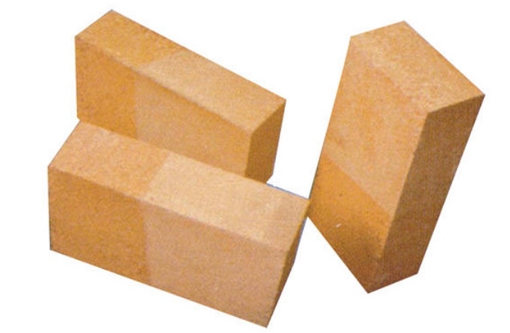- 29
- Sep
Magnesia alumina brick
Magnesia alumina brick

Magnesia alumina bricks are made of high-quality sintered magnesia and about 8% pure Al2O3 fine powder or high-quality high-alumina bauxite (Al2O3> 78%, SiO2 <20%, a small amount of Fe2O3 and other impurities), using sulfite pulp waste liquid as a binder , Alkaline refractory products made by batching, mixing, billeting, drying, firing and other processes.
The magnesium oxide content in the magnesia alumina brick is about 85%. The alumina content is 5% to 10%, the basic refractory material with periclase as the main crystal phase and magnesia-aluminum spinel as the secondary crystal phase (as the main binding phase). The apparent porosity is generally 15-18%. The coefficient of thermal expansion is 10.6×10-6/°C. The thermal shock resistance is better than the corresponding magnesia brick. Because the magnesium aluminum spinel with a higher melting point is distributed in the matrix, its high temperature strength is higher, and the starting temperature of load softening is above 1580°C. The slag resistance is also better. Generally, high-quality sintered magnesia is used as a granular material, and fine powder composed of magnesia and bauxite or light-burned bauxite clinker or industrial alumina is added in a certain proportion, and it is obtained by mixing, forming and firing.
1. Magnesia alumina bricks can be made by adding 5-10% Al2O3 to sintered magnesia. A12O3 is added in fine powder in the form of industrial alumina or high alumina bauxite clinker.
2. If Al2O3 is introduced with high alumina rock soil, it is bound to introduce impurities such as SiO2 at the same time, thus reducing the refractoriness and high temperature strength of the product. Therefore, the amount of alumina added should not be too large.
3. The process parameters for manufacturing magnesia alumina bricks are roughly similar to those of magnesia bricks. It is just that the firing temperature is generally higher than the firing temperature of magnesia brick by 30-50°C, reaching 1750-1800°C.
Magnesia alumina bricks have the following characteristics:
1. Magnesia alumina bricks have good thermal shock stability and can withstand water cooling for 20-25 times or even higher. This is its most prominent advantage. Magnesia alumina bricks have good thermal shock stability. Both magnesia alumina spinel and periclase belong to the cubic crystal system. The thermal expansion along each crystal axis direction is the same, so the expansion and contraction are both when the temperature fluctuates. It is more uniform and produces less thermal stress.
2. The main properties of magnesia alumina bricks are also slightly stronger than those of magnesia bricks. Due to the higher melting point of the magnesia-aluminum spinel itself, the load softening temperature of the magnesia-aluminum brick is better than that of the magnesia brick, reaching 1620~1690℃.
3. The chemical composition of magnesia-aluminum bricks varies with different raw materials, generally MgO>81%, Al2O3 8.7%, SiO2<6.0%, CaO<1.5%, Fe2O3<1.0%.
4. The mineral composition of magnesia alumina bricks. In its mineral composition, the main crystal is periclase, and the matrix is composed of magnesium ferrite, forsterite, forsterite and magnesia spinel.
5. The refractoriness and load softening temperature of the magnesia alumina brick. In the magnesia alumina brick, the periclase crystals and the magnesia alumina spinel form a network framework. Although a small amount of low melting point impurities are filled in the voids of the network framework, the network framework is still It has the ability to resist high temperature and load, so the refractoriness and load softening temperature of magnesia alumina bricks are relatively high, the refractoriness can reach 2100℃, and the load softening temperature is 1570℃.
6. The thermal expansion and thermal stability of the magnesia-aluminum brick. Because the linear expansion coefficient of the magnesia-aluminum spinel is small, the linear expansion coefficient of the magnesia-aluminum brick is very small. In the range of 20~1000℃, the linear expansion coefficient of magnesia alumina brick is only 10.6×10-6℃-1. Because the magnesia alumina spinel plays a role in enhancing the thermal shock resistance in the brick, the magnesia alumina brick has better thermal shock resistance, and the number of water cooling is more than 20 times.
7. The slag resistance of magnesia-aluminum bricks. Because magnesia-aluminum bricks have high density and low porosity, periclase is surrounded by magnesia-aluminum spinel, and AI2O3 is a typical neutral oxide, so magnesia-aluminum bricks The ability to resist acid and alkaline slag erosion is relatively strong.
The ability of magnesia alumina brick to protect periclase particles from slag erosion is stronger than that of forsterite, so the ability of magnesia alumina brick to resist alkaline slag and iron oxide slag is strengthened.
Magnesia-alumina bricks have the above-mentioned excellent properties, so they have been widely used as masonry materials for the roof of high-temperature smelting furnaces such as steel-making open-hearth furnaces and copper-smelting reverberatory furnaces, and have achieved the effect of extending the life of the furnace. The large open hearth can reach about 300 furnaces, and the medium and small open hearth has more than 1000 furnaces.
